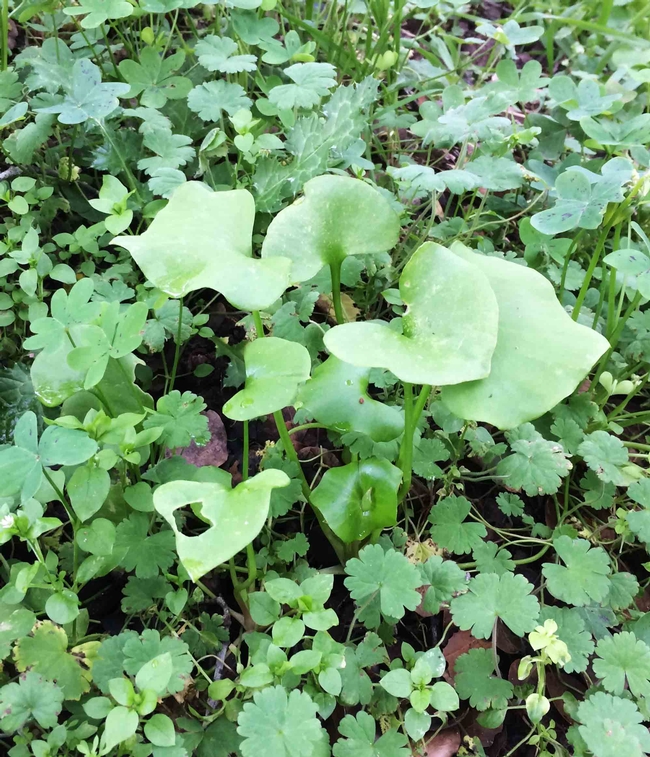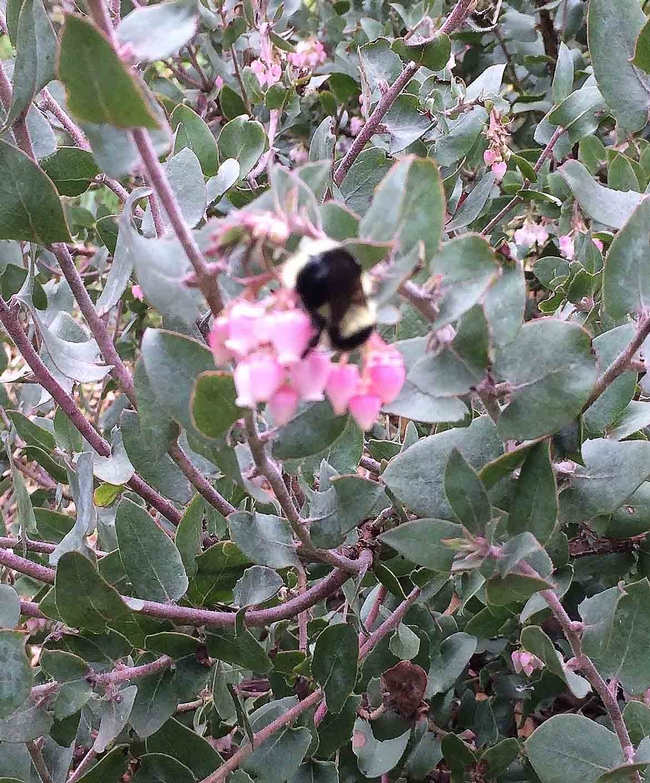Feb 5, 2017

Claytonia perfoliata, or miner's lettuce, a local native, is the spade-leaved plant in the center surrounded by non-native annuals and perennials.
Background. When purchasing native California plants to plant in your yard, native plant nurseries may offer a number of options. First there will be local native species -- those plant species that are found in your area naturally. Second, vendors might offer California natives from other locales. A good example of this is Eriogonum grande var. rubescens, or San Miguel Island buckwheat. This red buckwheat is a native California plant, but it is found naturally occurring only on Santa Rosa and Santa Cruz Islands in the Channel Islands. A third type of plant many vendors offer is a cultivar. A cultivar is a plant variety that has been produced in cultivation by selective breeding. A good example of a native cultivar is Arctostaphylos densiflora 'Howard McMinn,' a type of manzanita that is often used in landscaping and frequently offered for sale in native plant nurseries.
1. For natives that have numerous cultivars, select a local native if your garden is adjacent to wildlands. Avoid cultivars of Arctostaphylos (manzanita), Eriogonum (buckwheats), Ceanothus (California lilac), coast irises, Dudleya (a succulent), Mimulus (monkeyflower), etc., as these hybridize freely and may impact local native species. Check the horticulture trade for other species that have cultivars as this may be an indication of potential problems for wildlands. How flexible is the species? If it can be so easily manipulated in the horticulture trade, then its cultivars may have a greater likelihood of hybridizing in the wild. Unfortunately, research on this issue is scant and in its infancy, but your local nursery may have feedback on the behavior of some cultivars. Jackie Pasco defines a true "native" as a species that evolved over geologic time in the area it is found.
It also helps to look at what is stable among the native species on your property. On her property, Jackie has the native salvia, Salvia mellifera, and in her garden, some Salvia cultivars. The Salvia mellifera remains stable -- Jackie has not observed any changes in characteristics among its volunteers. It appears that her garden's Salvia cultivars are not hybridizing with S. mellifera.
It also helps to look at what is stable among the native species on your property. On her property, Jackie has the native salvia, Salvia mellifera, and in her garden, some Salvia cultivars. The Salvia mellifera remains stable -- Jackie has not observed any changes in characteristics among its volunteers. It appears that her garden's Salvia cultivars are not hybridizing with S. mellifera.
2. Borrowing from the defensible space model for fire-safe gardening, Jackie came up with defensible space recommendations for what she calls the Wildland User Interface (WUI). These recommendations apply to gardens and properties adjacent to wildlands.
- Within 25' of your home, plant what you want as long as it is not invasive.
 Arctostaphylos densiflora 'Howard McMinn' with a bumblebee feeding on its flowers.
Arctostaphylos densiflora 'Howard McMinn' with a bumblebee feeding on its flowers. - 50'-100' from your home, "blend into wild nature."
- 100' from your home, just be a good environmental steward. Your only intervention should be regular weeding.
3. The term "drought-tolerant" needs to be better defined. It is sometimes misused, as "summer-dry" is California's normal state of being. Dry summers are not drought conditions, but the distinction from summer-dry is important for wiser plant selections relative to regional climate and microclimates. For example, many succulents are drought-tolerant, while most California native species in our area are summer-dry and may also be drought-tolerant.
Don't forget to subscribe to our blog so that you receive an email notification when a new post goes up. If you have questions, contact us online, by phone or in person to get answers to your gardening quandaries!
